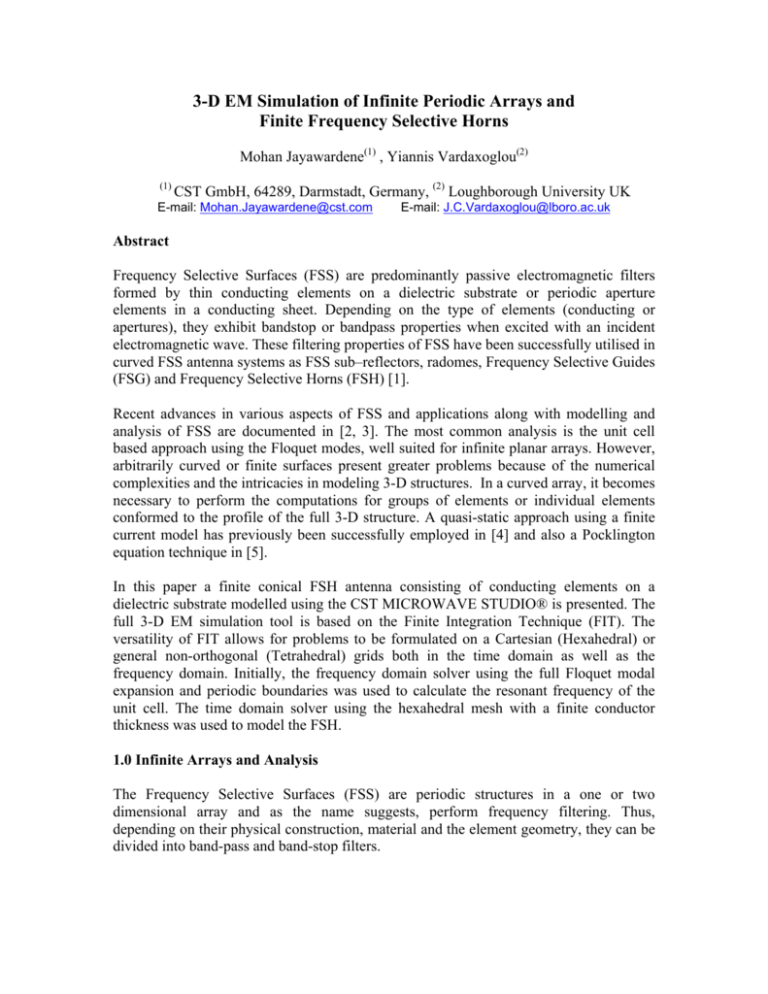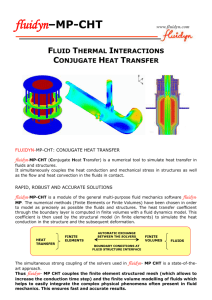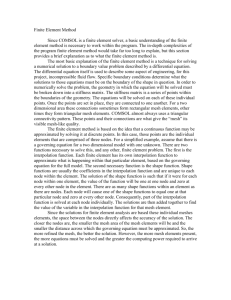3-D EM Simulation of Infinite Periodic Arrays and Finite Frequency
advertisement

3-D EM Simulation of Infinite Periodic Arrays and Finite Frequency Selective Horns Mohan Jayawardene(1) , Yiannis Vardaxoglou(2) (1) CST GmbH, 64289, Darmstadt, Germany, (2) Loughborough University UK E-mail: Mohan.Jayawardene@cst.com E-mail: J.C.Vardaxoglou@lboro.ac.uk Abstract Frequency Selective Surfaces (FSS) are predominantly passive electromagnetic filters formed by thin conducting elements on a dielectric substrate or periodic aperture elements in a conducting sheet. Depending on the type of elements (conducting or apertures), they exhibit bandstop or bandpass properties when excited with an incident electromagnetic wave. These filtering properties of FSS have been successfully utilised in curved FSS antenna systems as FSS sub–reflectors, radomes, Frequency Selective Guides (FSG) and Frequency Selective Horns (FSH) [1]. Recent advances in various aspects of FSS and applications along with modelling and analysis of FSS are documented in [2, 3]. The most common analysis is the unit cell based approach using the Floquet modes, well suited for infinite planar arrays. However, arbitrarily curved or finite surfaces present greater problems because of the numerical complexities and the intricacies in modeling 3-D structures. In a curved array, it becomes necessary to perform the computations for groups of elements or individual elements conformed to the profile of the full 3-D structure. A quasi-static approach using a finite current model has previously been successfully employed in [4] and also a Pocklington equation technique in [5]. In this paper a finite conical FSH antenna consisting of conducting elements on a dielectric substrate modelled using the CST MICROWAVE STUDIO® is presented. The full 3-D EM simulation tool is based on the Finite Integration Technique (FIT). The versatility of FIT allows for problems to be formulated on a Cartesian (Hexahedral) or general non-orthogonal (Tetrahedral) grids both in the time domain as well as the frequency domain. Initially, the frequency domain solver using the full Floquet modal expansion and periodic boundaries was used to calculate the resonant frequency of the unit cell. The time domain solver using the hexahedral mesh with a finite conductor thickness was used to model the FSH. 1.0 Infinite Arrays and Analysis The Frequency Selective Surfaces (FSS) are periodic structures in a one or two dimensional array and as the name suggests, perform frequency filtering. Thus, depending on their physical construction, material and the element geometry, they can be divided into band-pass and band-stop filters. In 1919 Marconi first patented periodic structures [6], but work on FSS started with earnest in the early 60s [7] and concentrated on the use of FSS in Cassegainian subreflectors in parabolic dish antennas. Today FSS are employed in radomes (terrestrial and airborne), missiles and electromagnetic shielding applications. The analysis of FSS started with mode matching techniques which were first applied in waveguide problems. The mode matching method led to the approximate method of equivalent circuit analysis which gave a lot of insight into the behaviour of FSS since it was partly based on the transmission line principles. The modelling capability however was limited by the inability of the Mode Matching Method to model any FSS geometry and the inaccuracy the equivalent circuit method. With the advent of computers more accurate numerical techniques were developed for the analysis of FSS such as the method of moments (with entire or subdomain basis functions) the finite difference method and the finite element method. In this paper, we investigate modeling infinite periodic FSS arrays and finite FSS structures using CST MICROWAVE STUDIO®. The full 3-D EM simulation tool is based on the Finite Integration Technique (FIT). 2.0 Finite Integration Technique (FIT) The Finite Integration Technique (FIT) was first proposed by Weiland in 1976/1977 [8,9]. This numerical method provides a universal spatial discretisation scheme applicable to various electromagnetic problems ranging from static field calculations to high frequency applications in time or frequency domain. Unlike most numerical methods, FIT discretises Maxwell’s equations in the integral form of rather than the differential one. FIT generates exact algebraic analogues to Maxwell’s equations, that guarantee physical properties of computed fields and lead to a unique solution. Maxwell's equations and the related material equations are transformed from continuous domain into a discrete space by allocating electric voltages on the edges of a grid G and magnetic voltages on the edges of a dual grid G~ . The allocation of the voltage, flux components on the grid can be seen in Figure 1. The discrete equivalent of Maxwell's equations, the socalled Maxwell’s Grid Equations are shown in Eqs.(1)-(4). This description is still an exact representation and does not contain any approximation errors. d )) ) Ce = − b dt )) Sb = 0 (1) (3) ~ ) d )) )) Ch = d + j dt ~ )) Sd = q (2) (4) Figure 1: Electric voltage and flux components on a hexahedral mesh ) ) In these equations e and h denote the electric voltages between grid points and the )) )) )) magnetic voltages between dual grid points, respectively. The symbols d , b and j are fluxes over grid or dual grid faces. Due to the consistent transformation analytical properties of the fields are maintained resulting in corresponding discrete topological ~ ~ operators on the staggered grid duplet. The topology matrices C , C , S and S correspond to the curl and the div operators. The tilde indicates that the operator belongs to the dual grid. he discrete analogue of the coupling between voltages and fluxes is represented by the material matrices M ε , M μ −1 and Mκ . )) ) d = Mεe )) ) h = M μ −1 b )) ) )) j = M κ e + jA (5) (6) (7) Now all matrix equations are formulated and available to solve for any electromagnetic field problems using the discrete grid space in the time domain. In addition to orthogonal hexahedral grids, FIT can also be applied to more general mesh types such as topologically irregular grids (subgrids) and tetrahedral grids, respectively. The picture below shows the allocation of the electric voltages and magnetic fluxes on a tetrahedral mesh cell. The application of FIT to more general meshes can be see as an extension of the formulation described above Figure 2: Electric voltages and magnetic fluxes on a tetrahedral mesh 2.1 Perfect Boundary Approximation technique (PBA) Conventional wisdom often claims poor structure approximation to be a major disadvantage of staircase meshes. Perfect Boundary Approximation technique (PBA) overcomes this limitation enabling excellent solutions even with comparatively coarse grids. PBA takes into account the thickness of metallic sheets or strip lines within one grid cell, without explicitly meshing it. The consideration of field singularities of electromagnetic field on edges additionally reduces the number of mesh points necessary to reach a precise field and impedance computation. PBA demonstrates its fundamental advantage particularly clearly if fine metallic layers are oriented along grid planes like in the case of a PCB but also for rounded structures where the number of mesh points necessary is reduced by orders of magnitude. 3.0 Unit cell modeling - infinite array Prior to modeling a finite FSS structure the fundamental step in the design cycle is to identify the resonant frequency of the unit cell. Apart from the geometry of the unit cell element, material properties, conductor and substrate thickness the most influential parameter that has a significant impact on the resonant frequency is the angle of incidence of the plane wave. In MICROWAVE STUDIO® the infinite periodic array is simulated using unit cell boundary conditions where the phase connects two opposite boundaries with a definable phase shift such that the calculation domain is simulated to be periodically expanded in the corresponding direction. Thus changing one boundary to unit cell always changes the three other boundaries to define an infinite periodic array in x and y directions. The boundaries perpendicular to the unit cell are left open and the incident plane wave is realised using Floquet modes. As mentioned above the incident angle (spherical angle) of the plane wave is explicitly defined by two parameters θ and φ. In order to model arbitrary angles of incidence in MICROWAVE STUDIO® the frequency domain solver was used. The general purpose Frequency Domain Solver solves the problem for a single frequency at a time, and for a number of adaptively chosen frequency samples in the course of a frequency sweep. For each frequency sample, the linear equation system will be solved by an iterative (e.g. conjugate gradient) or sparse direct solver. The solution comprises the field distribution as well as the Sparameters at the given frequency. For the discretisation of the geometry the hexahedral mesh as well as the tetrahedral mesh may be chosen on demand right before the solver start. The transient solver could also be used to model unit cells at normal incidence. Choosing opposite boundary pairs to be electric and magnetic walls enable a unit cell to be modelled. Figure 3 shows unit cell consisting of dipole elements modeled in MICROWAVE STUDIO®. Here the x and y boundaries are chosen to be of type unit cell whereas the z boundaries are left open. The incident plane wave is defined using Floquet ports as mentioned above. The solver enables as many Floquet modes to be defined for each port. In this simulation only 2 modes are chosen as the incident plane wave is defined by the very first Floquet mode. Top and bottom open boundaries Unit cell dimensions length (l)=7.7 mm, thickness of substrate (s)=0.1 mm, periodicity in X (Dx)= 10mm, periodicity in Y (Dy)= 10mm, width (w)=0.35 mm Unit cell boundaries on the side walls Figure 3: Infinite array modeled as a unit cell. Dotted line show the unit cell area considered for the simulation Figure 4 shows the meshing of a unit cell using the frequency domain solver with tetrahedral mesh. The transmission response using 2 Floquet modes per port at normal incidence converged after 3 adaptive passes. The total run time on a 2GHz single processor machine with a broadband frequency sweep took 23 minutes to complete with 10 frequency samples. Figure 4: Tetrahedral mesh shows the unit cell along the S-parameter convergence for maximum of S parameter deviation of less than 0.01 for two consecutive passes The transmission response of the unit cell is obtained by a broadband frequency sweep ranging from 10 – 20 GHz. As seen in Figure 5 the resonant frequency changes with the angle of incidence. Here the incident angle of the plane wave is changed from 0 degrees to 40 and 70. As the angle is increased the resonant frequency becomes lower. It is a well established fact that dipole elements are unstable with the direction of the incident plane wave [2]. Figure 5 clearly demonstrates that a frequency shift of 1.76 GHz is apparent for an incident angle variation of 70 degrees. 0 -5 Transmission Coefficient (dB) -10 -15 -20 -25 -30 -35 -40 0 degree incidence Higher order grating lobes 40 degree incidence -45 70 degree incidence -50 10 11 12 13 14 15 16 17 18 19 20 Frequency (GHz) Figure 5: TE incidence variation for a unit cell consisting of a conductive dipole array Electric field and Surface current animations provide an insight into the resonant behavior of the unit cell. For each simulation frequency, field monitors can be defined to obtain parameters defined above. Figure 6 below shows an animation sequence of the electric field plotted in the direction of propagation. Here the incident angle is 0 degrees. At the resonant frequency (15.67 GHz) of the array the most of the energy is reflected back to port 1, where as at 5 GHz the incident plane wave travels unperturbed to port 2. Port 1 E k Port 2 Incident E field propagates from Port 1 to Port 2 5 GHz – out of band Port 1 E k Port 2 Incident E field is reflected back to Port 1 to Port 2 15.67 GHz – in band Figure 6: Animation of the E field, dotted red line shows the perimeter of the unit cell 4.0 Finite Arrays – Frequency Selective Horns (FSHs) The property of Frequency Selectivity has been extensively used many finite structures as large radomes for military applications [10] and frequency selective waveguides [11, 12]. Here we investigate horns with frequency selectivity. In principle, they take the shape and size of a solid conical horn for a particular frequency band, but their walls are replaced by a FSS. Due to the ease in fabrication and the performance FSHs find many applications where lightweight and inherent multi-band capabilities are desired. One such application area is the design of a dual band antenna with equal beamwidths and gain. The horns could be independently fed at the two different bands and formed by mounting the structures coaxially. Other areas of interest include base station antennas, curved filters and smart antennas. For fixed frequency applications, the FSH may already offer significant advantages in terms of weight and out of band RCS, both of which should be lower than for comparable solid horns. FSH horns have been previously investigated using a quasi-static approach [1, 4]. In this paper the finite structure is modeled in MICROWAVE STUDIO® and the complete antenna performance is predicted for different element types. At the resonant frequency the FSH performance is very close to that of a metallic solid horn of the same dimensions and away from resonance the horn becomes inert. The wavelength of resonance λr , is approximately twice the element length (2l ) for a dipole array and 4l for tripole and square loop arrays, where l is the length of element. For the circular loop λr = 2π ( Rin + 0.5w) , where Rin is the inner radius. The element width w is in most cases much smaller than its length 4.1 Finite horn with dipole elements Figure 7 below shows the dimensions of the horn used for the dipole array FSH. In order to obtain symmetrical radiation patterns the elements are printed in polar periodic arrangement. From the conical geometry, it is evident that certain design constraints exist, especially where the periodicities of the elements are concerned. Figure 7: Dimensions of the conical horn The FSH was designed in MICROWAVE STUDIO® with dipole elements arranged in a polar periodicity. In total 448 are periodically placed on the surface of the conical horn were the slant axial periodicity is 16 and the polar periodicity is 12.85°. The hexahedral mesh in the Transient Solver is used in combination with the PBA allows for efficient meshing of the curved surface with thin metallic elements. Further more to reduced the complexity of the problem symmetry boundary conditions are used. Since the FSH is excited using the fundamental TE11 mode from a circular waveguide and the FSH is symmetric along its central axis along the apex, the yz plane is defined as a magnetic wall where the tangential magnetic field vanishes to zero. Similarly, the xz plane is defined to be electric as the tangential electric field at this boundary vanishes to zero. A total of just over 2 million mesh cells were used to define the FSH with symmetry conditions. magnetic wall (Ht=0) open boundaries circular waveguide y 0.1 mm thick substrate with low loss ( tanδ=0.0001) x z Dipole dimensions l=7.7mm, w=0.35mm polar periodicity=20.1 electric wall (Et=0) Figure 9 : MICROWAVE STUDIO design of the FSH Figure 10 : Radiation patterns E-plane and 3D plot at 15.5 GHz Figure 10 shows the radiation pattern of the FSH at 15.5 GHz with a gain of 11.74 dBi. In order to further improve the performance a ring array FSH was designed with half the size length of the dipole FSH shown in Figure 7. Since ring elements have stable angular stability as well as dual polar capabilities rings are better suited such antennas. However due to the curvature of the element more mesh cells are needed define the structure accurately. The tightly packed array of FSS consists of rings with an internal diameter of 5.55 mm and a track width of 0.35 mm. The radial periodicity of the array is 7.15 mm. The ring FSH consists of 10 million mesh cells and a broadband response in frequency from 12 -18 GHz is obtained using the Transient solver. Figure 11 below shows the return loss response and the E and H radiation patterns. Operational BW Figure 11 : FSH with ring elements. (a) mesh view (b) S11 (c) Radiation patterns (d) E field animation Conclusions In this paper we have demonstrated that MICROWAVE STUDIO® can be used in the frequency domain and time domain to solver FSS arrays of infinite and finite nature. Full Floquet modal expansion and periodic boundaries was used to calculate the resonant frequency of the unit cell. The time domain solver using the hexahedral mesh with a finite conductor thickness was used to model the FSH. Results with dipole and ring elements showed how a smaller horn with ring arrays give better results in terms of gain and pattern response compared to dipole elements. References [1] [2] [3] [4] [5] [6] [7] [8] [9] [10] [11] [12] JAYAWARDENE, M., LOUKOS, G., VARDAXOGLOU, J.C. : ‘Inband radiation performance of conical horn with printed elements’, QMW Antenna Symposium Queen Mary and Westfield College, 1996. VARDAXOGLOU, J.C. : ‘Frequency Selective Surfaces Analysis and Design’, Research Studies Press, John Wiley & Sons, 1997, pp. 77-113. WU, T.K. : ‘Frequency Selective Surface and Grid Array’, John Wiley & Sons, 1995. CHIA, Y.W. : ‘Scattering from curved (conical) frequency selective surfaces’, PhD thesis, Loughborough University, Loughborough, Leicestershire, UK, 1994. SAVIA S.B., PARKER E.A., PHILIPS B : ‘Finite Planar- and Curved-RingElement FSS’, Proc. IEE, Microwaves, Antennas and Propagation , Vol 146,No.6, pp, 401- 406 Dec 1999. MARCONI G, FRANKLIN C.S., ''Reflector for use in wireless telegraphy and telephony'', US Patent 1,301,473, April 1919. AGRRAWAL, V.D., IMBRIALE, W.A. : ‘Design of a dichroic Cassegrain Subreflector’, IEEE Trans., 1979 AP-27, pp. 466-473. WEILAND, T. “A Discretization Method for the Solution of Maxwell's Equationsfor Six-Component Fields”, Electronics and Communication, (AEÜ), Vol. 31 (1977), p. 116. MICROWAVE STUDIO®, User Manual Version 2006. MICROWAVE STUDIO®, Perfect Boundary Approximation are trademarks of CST GmbH. J.C. VARDAXOGLOU, M. JAYAWARDENE and N. TSAMPIERIS, “A Streamlined low RCS frequency selective radar antenna”, Joint IST/SET Panel Symposium Chester, UK, 7-9 April 7-9 2003. LOUKOS, G. : ‘Propagation of Cylindrical Frequency Selective Guides’, PhD thesis, Loughborough University, Loughborough, Leicestershire, UK, 1997. EADE, J.C., COX, G.C., SEAGER, R.D., VARDAXOGLOU, J.C. : 'A study of Frequency Selective Waveguides (FSG) of Circular Cross Section.' 22nd QMW Antenna Symposium, Queen Mary and Westfield College, April 1998.








